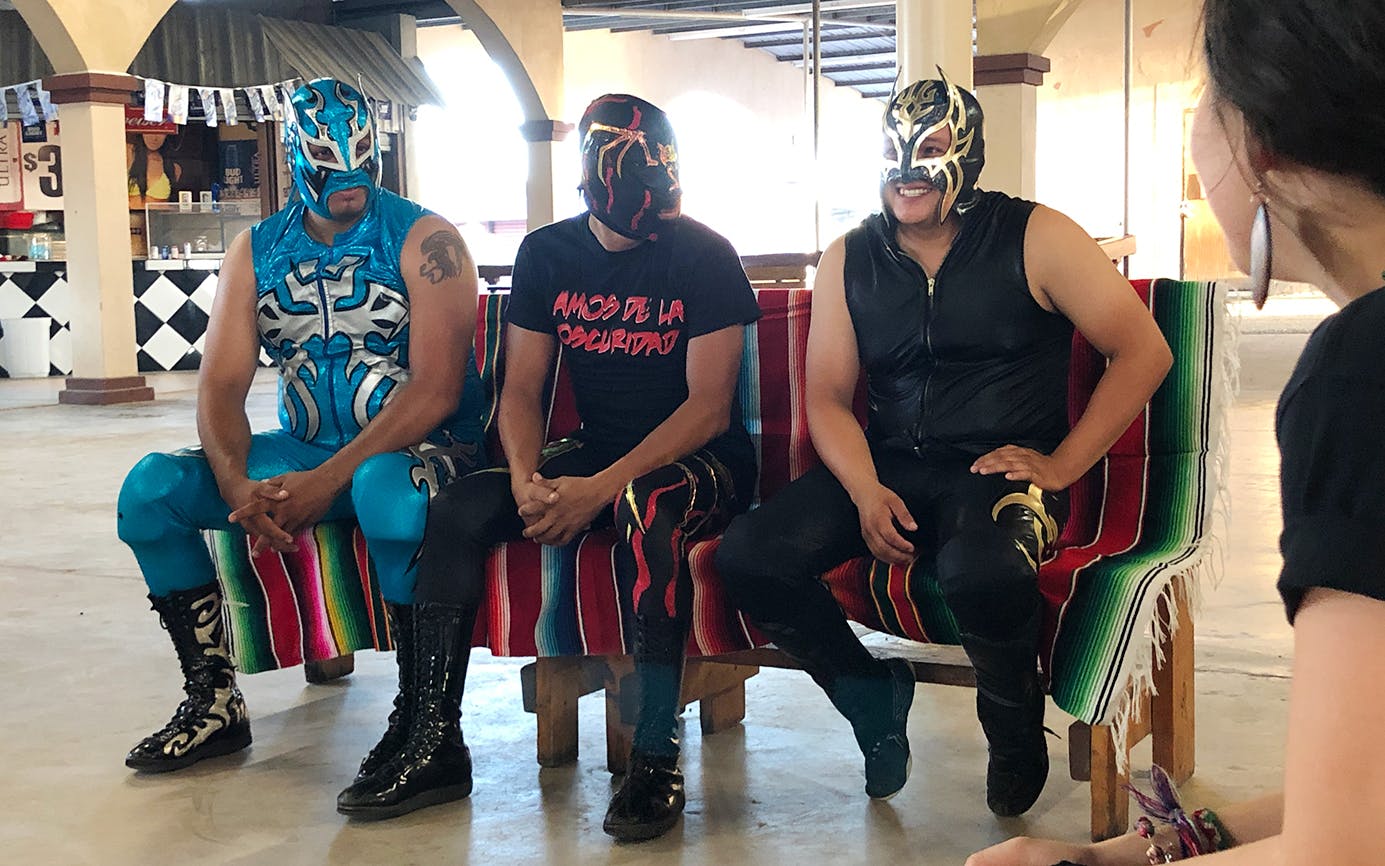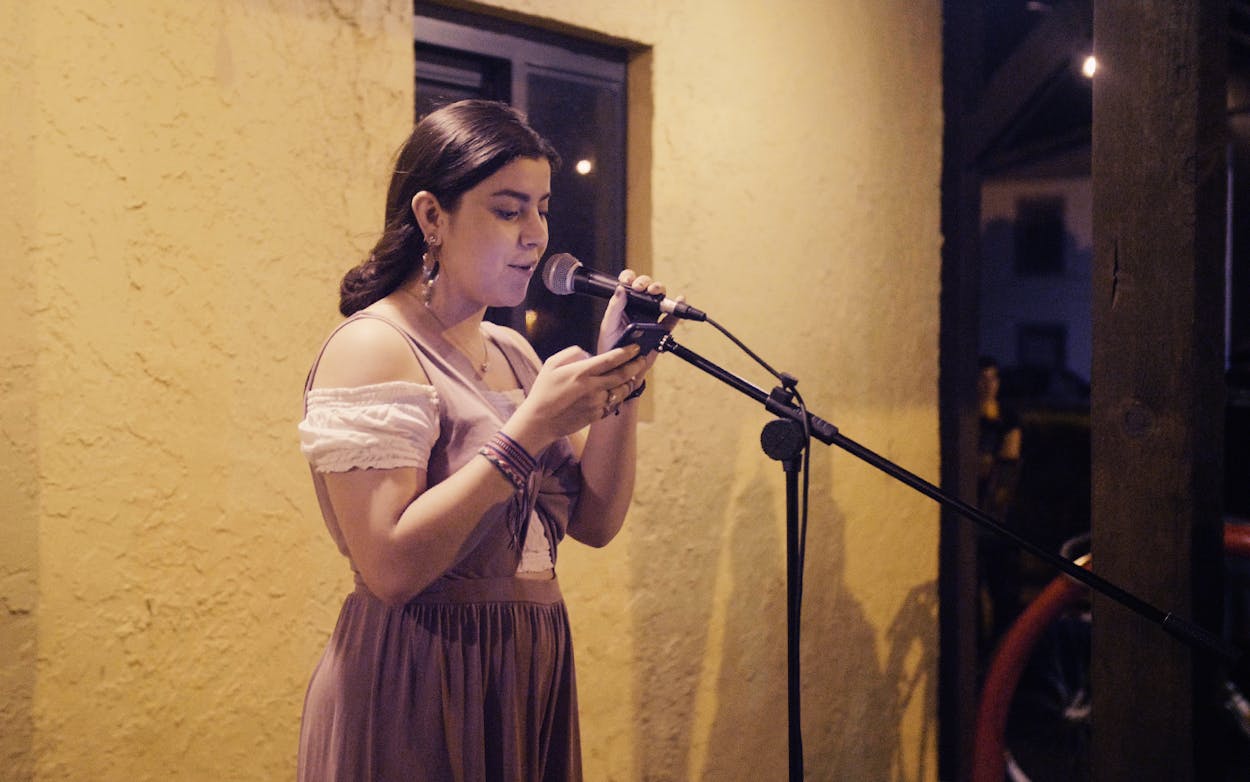On a recent balmy afternoon in Brownsville, the Carlotta K. Petrina Cultural Arts Center opened its doors—and windows—to feature works from artists in the Rio Grande Valley and the neighboring city of Matamoros, Mexico. One painting in particular, “Me Raja, Me Raja,” by local artist Emily Hinojosa, stopped many onlookers cold. It depicted a nude brown woman who had an S-shaped, bloody cut running down from her shoulder to between her legs, and then to the bottom of the canvas. A stretch of barbed wire bearing the same shape ran alongside her. The wound appeared fresh.
While the show’s selections aptly represented the borderland region’s complex narrative, few pieces spoke as intimately to the particular pain felt by this community as did Hinojosa’s. Her piece draws its name from a treasured literary work from the Valley, Gloria Anzaldúa’s semiautobiographical poetry and prose collection, Borderlands/La Frontera: The New Mestiza. In it, Anzaldúa refers to the border as an open wound splitting her flesh. That wound is not just the physical barrier that the border represents between people, families, livelihoods. It’s also a metaphor for the deeper understanding one has here of the violence the federal government has inflicted upon the borderland, in both the United States and Mexico.
The exhibit was part of Encuentro en la Frontera, a new three-day festival seeking to uplift the Valley through art, education, and activism. The Encuentro, which took place this month in McAllen, Alton, and Brownsville, aimed to “create safe spaces for creativity and community support by developing solidarity resource networks with more than thirty artists, organizations, and cultural centers from both sides of the Rio Grande.” Unlike the mainstay Charro Days and the more recent MXLAN Festival, both of which were put together with the help of municipalities, Encuentro en la Frontera was organized by Damariz Damken, a Valley native who recently graduated from NYU with a degree in Politics, Rights, and Development.

While conducting interviews with RGV locals for her undergraduate thesis on border regions’ interconnectivity, Damken discovered a curious pattern among local activism efforts. “I came to see how there are so many movements and organizations going on across the Valley, but there is just a gap … in terms of mobilizing and organizing,” she says. “I think that everyone respects each other’s work … but I didn’t see that there was a situation in which that all kind of came together.” Damken then decided that she needed to give back to her community with a project that helped unify these movements.
On the heels of her college graduation this past spring, Damken was awarded a Social Impact Grant by the Liberal Studies school at NYU so she could organize an event along the southern United States border. Her goal was to bring together forces already working within art and activism, and invite the RGV community to engage with them as an act of political resistance. She drew inspiration from her time with the Hemispheric Institute of Performance and Politics, who organize a huge event, an “encuentro,” every two years. Since Damken’s event would take place at and specifically focus on the border, her encuentro would be “en la frontera.”
Drawing from the contacts she made during her thesis research, Damken put together a network of leaders, local artists, and creatives to help the festival take shape (Disclaimer: I was one of the people Damken contacted for insights). By taking place at different venues in different cities within the Valley, Encuentro en la Frontera sought to provide safe spaces for communities to speak frankly with one another about their identities, art, and futures, while also being able to let loose to the sounds of local musicians and DJs. The festival also served as a donation drive for the Angry Tías and Abuelas, an organization that supports asylum-seekers and visitors to the Humanitarian Respite Center after they are processed by Border Patrol agents.
The festival opened at Grain to Glass (a popular craft beer establishment in McAllen) with a plática, or conversation, led by Christina Patiño Houle, founder and codirector of the Brownsville art collective Las Imaginistas and network weaver with Rio Grande Valley Equal Voice Network. In both English and Spanish, Houle led a discussion between Ramona Casas of ARISE, a program that works with colonia families, and Rubén Garza, an Art & Community Change Fellow with Las Imaginistas. The conversation—rooted in dreaming and imagining, and the roles they play in visualizing the future toward which a community could actively work—lay the groundwork for the festival.

That night, Poets Against Walls held an open mic where people shared their own works, stories, and concerns. One young woman chose to share her grief, telling the story of her grandfather, who, terrified by the current administration’s persecution of immigrants, took his own life a month ago. Through telling these stories, the Valley has a chance to form its own narrative instead of letting itself be defined by the media, notes Poets Against Walls organizer César Leonardo De León. “The border is not some imaginary barren wasteland, there’s actual people that live here, who have lived here for hundreds of years,” he says. “They need to know that we exist, we have voices, we have stories. It’s not just a twenty-second clip on Fox News or CNN or whatever news channel, it’s not just a 140-character tweet. There’s real things going on here, and we want folks to know what we’re about.”
Over the Encuentro’s three days, participants were invited to tell their stories through different mediums and by attending one of the workshops at the arts center. In one room, Poets Against Walls hosted a Lotería Poetry workshop, where participants were asked to write a poem inspired by whichever lotería card they were presented with. In another, DJs Momo and JoJo of the Chulita Vinyl Club and local DJ Flacucho gave people a crash course in DJing with both analog and digital platforms. Next door, Josue Ramirez, a local artist and Cultural Organizer at Neta, a Latinx-run progressive media platform based in the Valley, hosted a collage-making workshop while short films by Valley filmmakers screened in the adjacent gallery. In the atrium, local musician and lifelong skater Carmen Castillo invited participants to build skateboards from scratch, using planks of wood she had found in a nearby alleyway. Some people adorned their boards with flowers and simple designs, while others were more intentional with their artwork: one attendee’s board was emblazoned with the words “FUCK ICE,” and another’s had a bright red anarchy symbol painted on a black background.


By taking place in several cities throughout the Valley, the Encuentro highlighted key points of intersection in the region. One of those places is Pulga los Portales, the flea market in Alton, Texas, where the festival held its final day of festivities. Michelle Vallejo, a social entrepreneur and second-generation owner who operates the Pulga alongside her father, Daniel Vallejo, has devoted her time to putting on cultural events there, including fashion shows, art show pop-ups, and concerts. Just last month, the Pulga was slated to host the Valley’s biggest indie pop show to date, by the California musician Cuco (it’s since been rescheduled for December). There isn’t another pulga in the Valley that has attempted to expand their scope in this way, and to reflect the interests of the people who frequent it. “No matter what, even though it is a place of commerce, a market that has less regulation and more freedom for the people to create the life that they want for themselves is community work,” she says.
The festival’s final night featured an especially critical experience for people in the Valley: a Know-Your-Rights training hosted by Ricky Garza, a fellow and staff attorney at the Texas Civil Rights Project. It focused on what people do and do not have a right to do when stopped by police during acts of civil disobedience, but could also apply to any traffic stop or encounter with the law. Considering that the entire RGV is within 25 miles of the border, and is teeming with Border Patrol agents on any given day, the information shared in this presentation—all of which is public knowledge—could mean the difference between going home or getting arrested. Or, in worse cases, being unlawfully detained under suspicion of being undocumented.
For all it set out to achieve, the Encuentro en la Frontera festival hit every possible mark. It brought artists and organizers together with residents, and fostered a greater sense of awareness than had existed in the region before. In the world of organizing, where movements are often measured in retrospect, it can be difficult to see the long game. But if ripples of change like the Encuentro continue to be made throughout the community, huge waves of action will follow. “The point of the Encuentro, at the most basic level, is to allow ourselves to see each other and see our own reflection and feel empowered by that,” Damken says. “By our own capabilities and our own possibilities.”
(Editor’s note: This article has been amended to reflect that Rubén Garza is an Art & Community Change Fellow with Las Imaginistas.)
- More About:
- Art
- Rio Grande Valley
- McAllen
- Brownsville






